The Greek Cheese
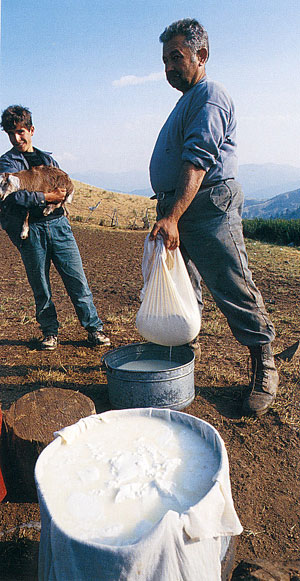
The history of Cheese is as old as human history. From the very first moment men occupied with agriculture and animal breeding, they had to search for methods conserving their milk. So, they started transforming it into butter, yoghurt and cheese. The first evidence of cheese consumption dates back in 8,000 BC. Later on, in Ancient Athens cheese was in trade in the market of the town and there are several scripts with cheese making recipes. Ancients Greeks were keen on eating cheese with honey and fresh fruits. They used to eat very well ripened and salted cheese which was used in several cooking versions or even sweets.
Ancient Romans were great cheese makers and they used to consume big quantities of cheese as well. They had cheese for lunch with fruits and wine. They had developed cheese making so much that they were controlling its flavor by feeding the animals with herbs like Oregon, thyme etc. Romans used also to add spices in the cheese or conserve it in oil or wine.
Greeks have greatly affected by their neighbors as far cheese making is concerned. In modern years they visited Italy in order to learn new methods of its production but I should also admit the Greece has its own tradition in cheese production as well, which is rich especially in mountainous areas and peculiar in the islands. According to scripts dating back to the 15th century, Cretans were excellent cheese makers while other scripts confess that cheese was the daily meal of poor people during Byzantium years. Some years later, when Turks conquered Greece, nomadic populations could travel to the mountainous areas where without being disturbed by the conqueror, exchanging their experience and techniques in cheese making and finally creating the foundation for the Greek Cheese.
Several types of cheese are produced exclusively in designated areas of Greece and thus have been standardized as Protected Designation of Origin (PDO) products. The conditions that should be fulfilled for a PDO cheese concern the area within which the animals are fed, the animals' kind, the area where the cheese is produced, the prohibition of chemical ingredients in the cheese, , the prohibition of antibiotics in the milk and the traditional methods of the production procedure.
Greece has in total 20 PDO cheese types, certified by the European Union while some further cheese types are under investigation in order to be listed as PDOs too.
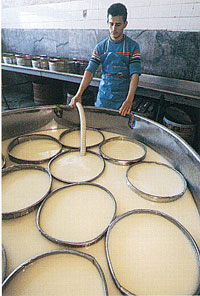
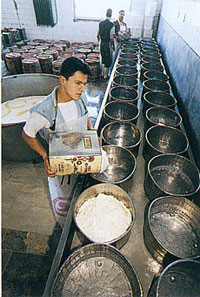
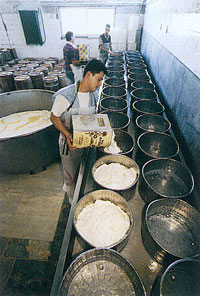
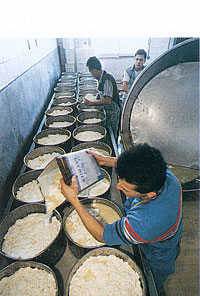
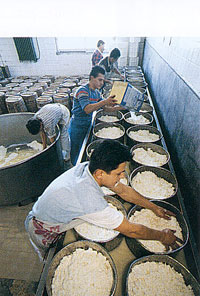
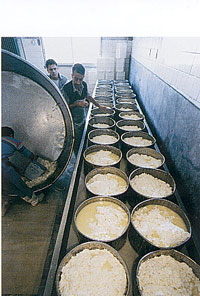
Greek cheeses
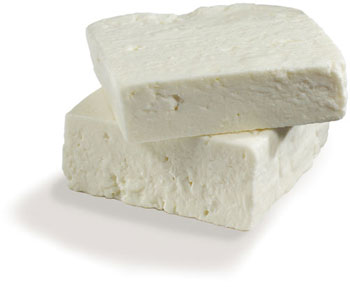
Greece is a country rich in cheese production as agriculture and animal breeding have been being a very important part of its habitants' daily life since ancestry. This has lead to their obtaining a great experience in cheese making as well as to continuously developing the cheese recipes, while preserving the traditional ones. Each greek area has its own unique recipes as the different climate conditions impact the cheese production through the breeding of the animals that produce the milk for the cheese making.
To begin with, I have to introduce you to the national cheese of Greece, Feta. It is an internationally famous cheese exported in several countries all over the world but I think that its taste is unique if you eat Feta in any greek place! Nowhere else would you taste it in a fresh Mediterranean salad dressed with plain olive oil and accompanied by the greek traditionally prepared bread. Moreover, Greek have a unique know-how in cheese pie making which are a "must eat" when visiting Greece.
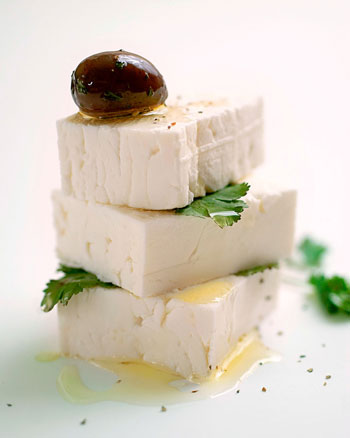
Feta cheese is a PDO product and there are specific areas in Greece where a cheese type called Feta may be produced, under designated conditions. So, Feta cheese you may taste from local producers in Macedonia, Thrace, Thessaly, Central Greece, Epirus, Peloponnese and Lesvos island. According to its standards, it must be made of sheep or sheep-goat milk and the animals producing this milk should be bred within the areas mentioned above. The reason is that the vegetation of these areas includes some unique species which affect the flavor of the animals' milk and of course the flavor of the cheese. At the same time, the traditional methods used for Feta making are the same as they used to be in the past and the cheese makers have become experienced and really skillful in that field which rends them unique.
The milk for the Feta cheese used to be unpasteurized in the past but nowadays its producers use pasteurized milk. It is heated in order to have it coagulated and natural or artificial rennet is added in it. Sometimes, sheep yoghurt can be used us a rennet.
The curd is then placed in molds in order to drain it and afterwards it is divided into slices, salted and left in low temperature chambers. It is finally placed in barrels with salty water and it can be consumed two months later.
Feta cheese should be served in low temperature (15-20 ºC) so as to preserve its smells which derive from the greek mountains. It has a strong flavor, usually sour and salty but some Fetas are less salty.
Greeks have invented several recipes with Feta cheese taking advantage of the unique taste of it. It can be used even in a sandwich with fresh tomato, Oregon and olive oil. I like baking it in a clay plate where I put a piece of Feta covered by a few tomato slices and green pepper pieces as well as some olive oil. It is also amazing for breakfast combined with fresh bread and a cup of greek coffee or as a starter before a meal. It can also be used a dip (cheese salad) if blended with spicy peppers and olive oil. The ways one can eat Feta are innumerous and I am still exploring them!
Macedonia cheeses
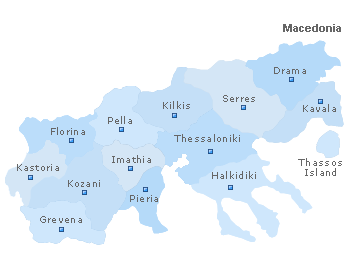
In the area of Macedonia we can find "kefalograviera" which is made of sheep milk (sometimes mixed with some goat milk). It is a white, hard and salty cheese with holes inside it. Kefalograviera is soft when it is fresh but it gets harder as time goes by. It is pressed several times after having been put in its block forms resulting in its being really massive. It is spicy and salty and it is usually served with ouzo ore wine.
It is ideal for frying in hot olive oil and then served with some drops of fresh lemon juice.
The next cheese type produced locally in Macedonia is called "Bandzos". It is a hard, white cheese preserved into salty water. It is made of sheep or sheep-goat milk based on the traditional recipe. The cheese makers have to hit the mixture in order to have a small quantity of the butter included in it removed. The best way of serving this kind of cheese is after having fried it. It will then get softer with great flavors. Bandzos has been listed as a PDO product since 1996.
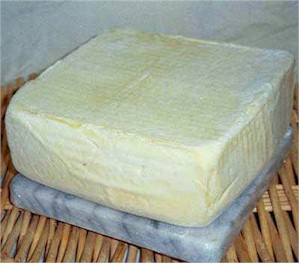
Telemes has been being produced in Macedonia since early 19th century, according to the traditional production methods. It is white and conserved in salted water. Telemes is made of sheep/ goat/ cow milk or a mixture of all the three and it is stored only in tinplate vessels. It is a compact, soft or semi-hard cheese, slightly sour and salted. It can accompany oily Mediterranean dishes, fruits or it can be used for a cheese pie.
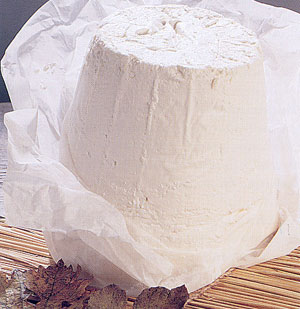
Mizithra can also be found in that area as in most mountainous greek areas. It derives from the whey of the production of other cheeses and it is a very popular greek cheese type that almost everyone is fond of. The milk may have been taken of sheep, goats or cows and it can be enriched with extra fresh milk. It has high level humidity (70%) and low fat content (50%). It has a sweet milky flavor and it is suitable for people on a diet. Sometimes it is slightly salted and this makes it ideal for pasta while fresh mizithra cheeses are served as desserts accompanied by honey, nuts or marmalade.
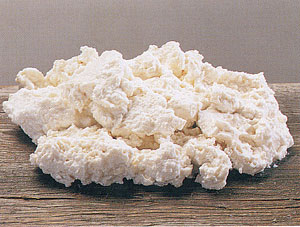
Macedonians produce, in my opinion, one of the best cheeses I have ever tasted in Greece. It is called Anevato and it is soft and granular. As it is creamy and unshaped, it can be eaten using a spoon. Anevato is made of sheep or goat milk (or a mixture of these two) providing the animals are fed within a specific area. It can be produced only in Grevena county and in Voios area, Kozani county. I was so impressed by this cheese type that I wanted to learn as much as possible for the procedure of its production. So, that's what I have learnt by its producers: It consists of 69% humidity and 3.5% salt. In the beginning, the milk is placed in a room where the temperature is around 20 °C until it gets acid and then it is put in cooling chambers with low temperature for 24 hours. Then the temperature must be higher and the rennet is added to the milk. The curd is then divided into pieces and left in the caldron for half a day and after that it is strained and salt is added. It needs two months to get ripened. It is acidulous, fresh and cool in flavor and slightly salted. I enjoy a milky smell when tasting it. It has been a PDO cheese since 1966 but it has been being produced for a lot of years.
Let me now introduce you to Victoria. It is not a woman but a cheese type produced within Thessaloniki County, made exclusively of cow milk and only from cows that belong to Hostein & Brawn Swits race which have to be fed only within that specific area. Victoria has a cylinder shape with a wax-coating. It is compact, yellow and has a mild taste. As it has a low fat content, it is suitable for people who are on a diet. It can be used for sandwiches, toasts, salads, pizzas etc. Unfortunately it is produced in a very small quantity so it is quite difficult to find it available for sale.
Thessaly cheeses
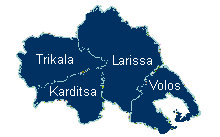
Directing to the south, Thessaly is also full of cheese makers with traditional recipes and unique flavors. I have tasted Touloumotiri which is a white and soft cheese, stored in bags made of sheep or goat skin. I had combined it with fresh hot bread prepared by a local woman and I am sure that I will never forget that specific flavor. Locals offered me Manouri cheese too. It is white and very soft, almost creamy as it is made of full fat fresh milk and usually fresh cream is added in the mixture. It is made of the whey of other cheeses and I was told that the best quality Manouri is made of hard cheese whey. The mixture is then put in molds made of cloth from which it gets its shape. I like it combined with salty or spicy crackers and a grass of red wine. This must be consumed while being fresh alternatively, if it gets dry, one can use it grated for pasta. It is considered to be a high quality cheese and it has been listed as a PDO since 1996.
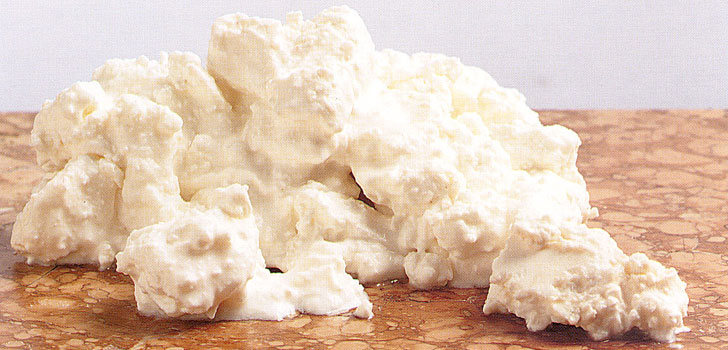
One of the most special cheeses of this area is Galotiri. It is a white cheese made of sheep or goat cheese. After having been stored in its container, extra fresh milk is added in the vessel whicn in turn is also transformed to cheese when coming in touch with the existing cheese. It is creamy and sour with a fresh flavor. I tasted Galotiri in Pilio where it was served with sausages in red spicy sauce and tsipouro. I can't wait coming back for one more round!!
Sterea Ellada (Central Greece) cheeses
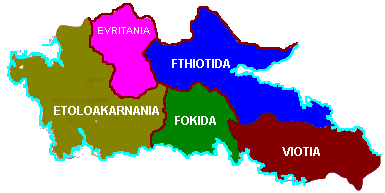
One of the most popular winter resorts of Greece is located in this part of Greece and it is named Arachova. People there make a traditional cheese type called Formaela. I was served a piece of it at a local restaurant. They had fried the cheese because, according to the specialist locals it smells even better and its flavor is even tastier. Its mass gets fibrous and it can be stretched pretty much when being hot and almost melted thanks to the frying.
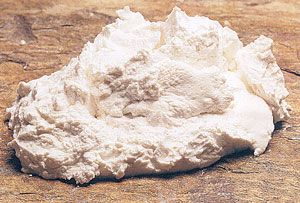
As a gruyere lover, I looked for a local gruyere and I was then offered a piece of gruyere produced in Agrapha village, Evritania county. It has a light yellow color and many small holes in its mass. It contains 40% fat, 38% humidity and almost 2.5% salt. It is made of sheep milk and this makes it a high quality gruyere. It has a fine smell and I can feel the butter flavor when chewing it. It can be combined with fruits, bread or any meal. It is often used as an ingredient in meat or vegetables baking, as it shabes a tasty crust after melting. Try it with raisin or melon!
Some kimlometeres away, in Domokos area, locals produce another cheese time called Katiki which is creamy, sour and elegant in flavor. It is ideally served with salads in vinegar dressing. In general, we could say that this part of Greece which is full of mountainous areas, is rich in various kinds of cheese making. I have tasted several hard and soft cheeses like Kefalotiri (hard, salty, spicy, nice smell), Telemes, Feta, Mizithra, Creamy Cheese and other.
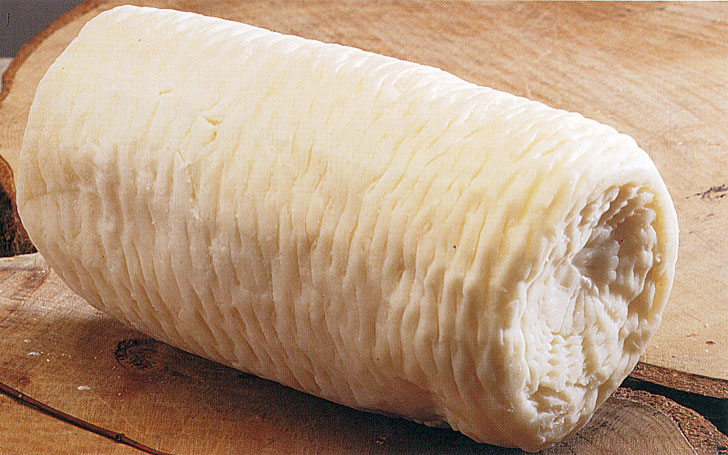
Epirus cheeses
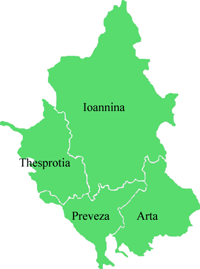
Located on the west part of Greece, it is an area highly developed in the field of cheese making. Some of the biggest cheese production factories of Greece have settled there. Apart from the common types like Feta, Kefalotiri, Mizithra and Manouri they also make their own Galotiri which is very thick and creamy like yoghurt, a bit salty and sour. Named after a village in Epirus, DODONI, one of these factories, produces a gruyere of cow milk which is ideal for fondues.
My visit to Metsovo town, Epirus, which is another really popular winter resort in Greece, was full of new tastes of cheese which impressed me. The most famous among them is Metsovone, named after its home town. It has a cylindrical shape and wax-coating. It is roped in order to be hanging from the ceiling of a smoking room where it is smoked. It is a yellow, semi-hard cheese produced using the "pasta filiata" technique. It takes 5 months to ripen it before smoking the cheese. The pasta filiata method was taught to young cheese makers from Metsovo town during their cheese making training in North Italy. Metsovone can be served baked or as it is. It has a smoky, rich and spicy flavor and I have used it for pizza topping several times.
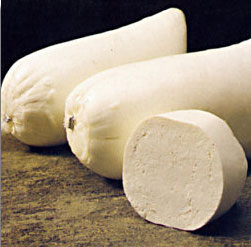
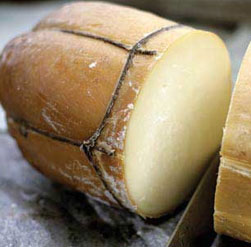
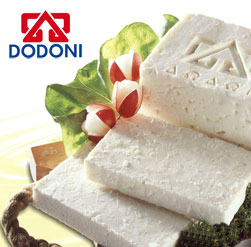
Apart from Metsovo, there is a second high quality cheese made in Metsovo town, Maisio. It is made of goat cheese and it contains black pepper. It is medium hard and it has a unique taste that seldom could anybody experience. I definitely recommend people who visit Metsovo buy some of that cheese as well as Metsovone, despite their being pretty expensive. Leaving Metsovo, I also took with me some gruyere and a piece of an amazing locally made parmesan that left me speechless when tasting them.
Ionian Islands cheeses
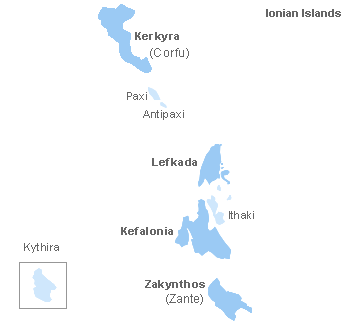
The habitants of Kefallonia island are considered to be excellent cheese makers who are often asked to visit other greek cities in order to offer their know how to cheese making. Despite the fact that they are not allowed to make Feta cheese in Kefallonia, they produce their own Feta-like which has a great taste and quality. I was advised to ask for the kefallonian Kefalotiri cheese by a friend who had visited that island before me and of course I did so. Well, it is a spicy cheese that I was served with honey and a glass of wine. It sound like a gourmet cuisine but it is a traditional product, amazingly delicious, very common to locals' daily meals. Some miles northerly, in Corfu island, the traditional Pecorino cheese is produced which has a black mould and is a great type too. In Zante, I tasted Ladotiri which has a square shape and reminded me of a over-ripened Feta, conserved in olive oil. Nowadays, it is not very easy to find this specific cheese type.
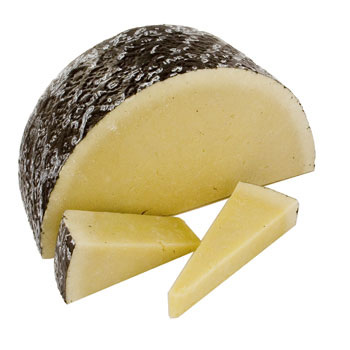
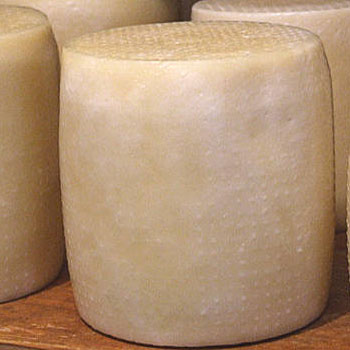
Peloponese cheeses
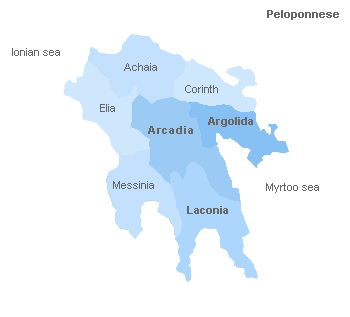
In the counties of Messinia and Lakonia, people produce Feta cheese, locally called Sfela or Fire Feta. It is a very old cheese type, white and conserved in wooden barrels with salty water. It is made of sheep or goat milk and its peculiarity is its being reheated after coagulation which gives the cheese a unique taste, salty, spicy, sour and with a rich flavor. I think that it is great just with some fresh bread but according to the locals it can also be combined with fruits or used for cheese pies. I also found a Mizithra cheese which was dry and is used for pasta (like parmesan but with a milder flavor that I think is perfectly harmonized with pasta). Formaela cheese is produced in Peloponese as well but it is enriched with pepper and herbs.
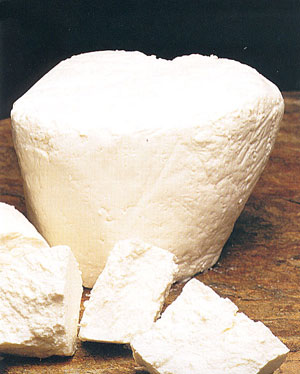
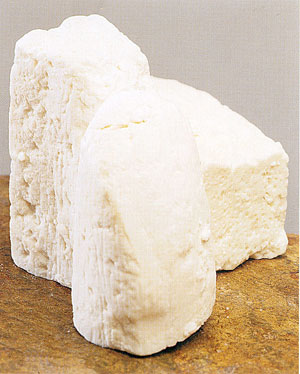
Aegean Islands cheeses
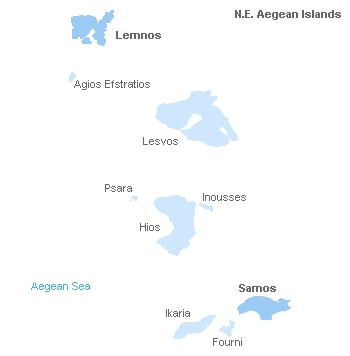
Aegean Sea has a lot of island complexes and each of them consists of many islands in which one may taste various cheese types produced locally. Tinos island, for example, has a long tradition in cheese making. I tasted Petroto, a cheese that is pressed between stones in order to ripen. It is made of cow milk and has a yellow color and a great taste. It was the first time I heard of Kopanisti cheese there which is a PDO for Cyclades. It is a creamy cheese, without a specific shaping with a white color with a very slight pink. It is made of sheep/ goat/ cow milk or a mixture of all the three which must have been unpasteurized. It is exposed in the sun so as to shape a pink crust around it and then it is twice mashed again in order to have the crust mixed with the rest of the cheese mass. It is then placed in clay pots where it pressed very well in order not to exist any air in it. It must be stored in a cool area and often people burry it in order to keep it in a low temperature. It is a blue-like cheese with a very spicy flavor.
Taking into consideration the fact that Cyclades are sun washed and consist of rare vegetation, lacking mountain with cool caves, its habitants had to find out alternative methods to conserve their cheese. So, they use the sun to dry it, they mix it very well and finally they put the cheese in the earth. What is more, the sea affects its vegetation which is salty resulting in the production of a salty, spicy cheese type. Bear in mind that us ripening grows old the cheese flavor gets different even within a week as it becomes even spicier and less acid.
It is perfectly combined with tsipouro or ouzo, by the sea...
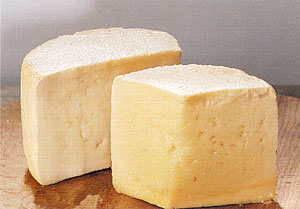
The most interesting part of my cheese research was the gruyeres. Most of the areas have their own gruyere which is different than the rest. As far as Aegean islands are concerned, I think that I have found my favorite gruyere in Naxos island. It is hard with golden color and dotted with innumerous small or bigger holes. It has a compact mass and an external hard crust. It is made of pasteurized cow milk and it consists of 38% humidity, 40% fat and around 3% salt. Once the coagulation has taken place the curd is cut in small pieces and is left for a "rest", for a few minutes. Afterwards it is mixed softly and heated. It is then shaped in big round pieces and pressed.
Continuously the cheese is put in salty water for four days and then put in wooden shelves in order to ripen, for 2 months.
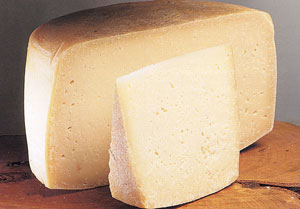
It has a slightly spicy but elegant flavor. I love the butter smelling of it. It is considered to be one of the best greek cheeses and it has been listed as a PDO cheese since 1996.
Tinos island habitants produce their local gruyere too. Included in the PDO as a greek gruyere (together with gruyeres from Agrapha and Naxos), it is made of cow milk having an excellent taste and smell. Locals are really experienced in cheese making as it has been proved by the long history of their traditional cheeses. Their gruyere has a wax-coating, golden color and some holes in its mass. It is spicy but not very salty, with a butter flavor. It can be combined with several food types but I prefer it as it is with some bread and of course a glass of wine.
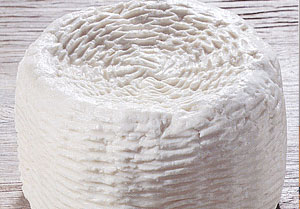
Lets go to the north Aegean Sea, in Limnos island. We can find a different cheese type there known as Kalathaki (basket), named after the shape it takes after having been put in a small basket in order to strain, before its ripening procedure. Made of sheep or sheep and goat milk, it has a white mass, without any exterior crust, and it consists of liquid fat drops. The milk is coagulated in a low temperature and then its mass is divided in small pieces. After straining it is placed in the small baskets in order to get rid of any water and then it is salted and put in small vessels with salt, for some days. After that it is washed and placed in vessels which include salty water. It is strained and placed in chambers with low temperature. This cheese has 54% humidity, 25% fat and 2.9% salt. Its flavor is similar to Feta but less acid. You can accompany it with fruits or any kind of food.
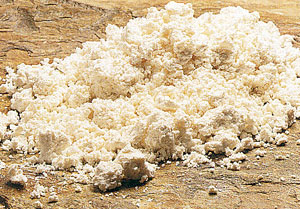
A neighboring to Limnos island, Lesvos is famous for its Ladotiri cheese. This one is hard and has a shape of a small head. It is yellow with small holes and it is produced exclusively in Lesvos island. It is made of sheep milk or a mixture of sheep an dgoat milk and the cheese is conserved in vessel that include olive oil. Due to the fact that it needs big quantities of olive oil in order to be conserved which would cost very much, it is possible to make wax-coatings for that cheese so as to trade it in other places. However, when being in olive oil it obtains a spicy flavor and the oil is harmonized with the rest ingredients of the cheese. It has been listed as a PDO cheese since 1996 and it is similas to the Ladotiri produced in Zante island.
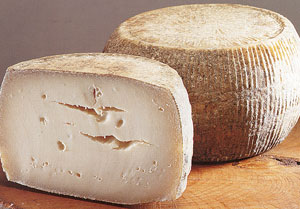
We will now travel to the south part of Aegean Sea, in particular Crete. Cretans produce a unique mizithra type cheese, named XInomizithra. It is smooth and creamy, white and unshaped. It is made of whey from goat or sheep or from a mixture of these two. It has 50% humidity, 23% fat and 2% salt. It is put in bags where it is pressesd very well, staying there for one week until it gets acid. After that it is placed in vessels or barrels and then in cooling chambers for two months in order to ripen.
Xinomizithra is very popular in Crete. My favorite snack is some small cheese-pies filled with xinomizithra which gets sweeter when baked. They are perfectly combined with cretan tsikoudia or ouzo. Xinomizitha is one of the oldest cheeses in Crete island and it has been being exported in Europe since 18th century.
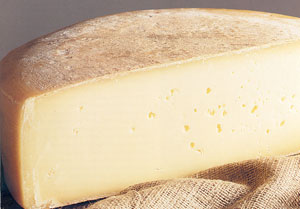
Chania county, Crete, are famous fro the Piktogalo cheese. It is creamy and smooth ideal for being spread on a slice of bread. A spoon is needed to eat this cheesewhich consists of 65% humidity, 50% fat and 1% salt. Thanks to its easy preparation procedure, it has been being consumed every day by the habitants of the mountainous areas of Chania county for many centuries. It is slightly salty and sour with a milky flavor or similar to yoghurt. It has been listed as a PDO cheese since 1996.
Let's move to the east, in Kos island. We will taste Possias cheese here which has a very tasty peculiarity as it ripens in wine remains. Made of sheep or goat milk or o mixture of them, it is shaped in long cylinders and after salting it is placed in barrels which contain salty water and wine remains. This method of conservation can keep it fresh for a long time but it should be taken out and dried before serving. It is colored after the wine outside while being totally white inside. It has an elegant smell thanks to the wine and it is soury and salty. It has 46% humidity, 28,7 fat and 2,2% salt. Locals serve it with fresh fruits and salads.
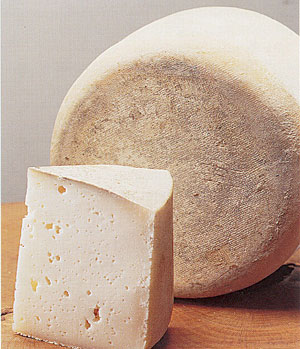
I will finally talk to you about of the greatest greek cheeses, San Michali which is produced exclusively in Syros island. San Michali cheese is produced only by cow milk from animals that are born and bred exclusively in Syros island. Cow milk cheese are mainly produced in Cyclades and locals have a long tradition in that, deriving from the period of the Venetian domination in these islands, when the first cows were brought to these area by Venetian monks. It is a hard, golden color cheese with a compact mass and many small holes in it. Its flavor can remind you of the Italian parmesan. It consists of 37 % humidity, 35% fat and 2-3% salt. The milk used for its preparation must be pasteurized and the curd is pressed in 4 different phases. It takes four months to ripen. It has a spicy, buttery flavor and an elegant smell. It can be fried, baked or combined with fruits. It has been listed as a PDO cheese since 1966.
Most of the cheeses mentioned above have been listed as PDOs and Greece should take pride of its cheese makers. Undoubtedly the natural environment and the landscape of this country have greatly affected the production of each cheese type but in any case their mastery has contributed in the development of this field.
I have already made a brief presentation of the most popular cheeses of Greece however it is sure that only some of them have been listed here as it was impossible for me to discover them all.





